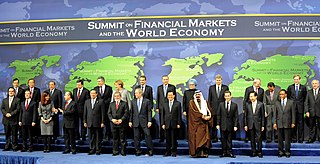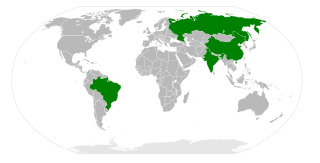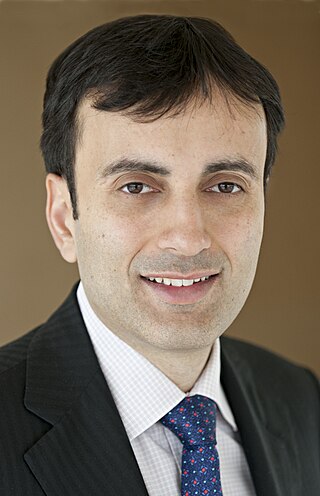Superpower describes a state or supranational union that holds a dominant position characterized by the ability to exert influence or project power on a global scale. This is done through the combined means of economic, military, technological, political, and cultural strength as well as diplomatic and soft power influence. Traditionally, superpowers are preeminent among the great powers. While a great power state is capable of exerting its influence globally, superpowers are states so influential that no significant action can be taken by the global community without first considering the positions of the superpowers on the issue.

A great power is a sovereign state that is recognized as having the ability and expertise to exert its influence on a global scale. Great powers characteristically possess military and economic strength, as well as diplomatic and soft power influence, which may cause middle or small powers to consider the great powers' opinions before taking actions of their own. International relations theorists have posited that great power status can be characterized into power capabilities, spatial aspects, and status dimensions.

A Middle power is a state that is not a superpower or a great power, but still exerts influence and plays a significant role in international relations. These countries often possess certain capabilities, such as strong economies, advanced technologies, and diplomatic influence, that allow them to have a voice in global affairs. Middle powers are typically seen as bridge-builders between larger powers, using their diplomatic skills to mediate conflicts and promote cooperation on international issues.

In international relations, regional power, since the late 20th century has been used for a sovereign state that exercises significant power within its geographical region. States that wield unrivaled power and influence within a region of the world possess regional hegemony.

Jagdish Natwarlal Bhagwati is an Indian-born naturalized American economist and one of the most influential trade theorists of his generation. He is a University Professor of economics and law at Columbia University and a Senior Fellow in International Economics at the Council on Foreign Relations. He has made significant contributions to international trade theory and economic development.

The economy of Asia comprises about 4.7 billion people living in 50 different nations. Asia is the fastest growing economic region, as well as the largest continental economy by both GDP Nominal and PPP in the world. Moreover, Asia is the site of some of the world's longest modern economic booms.

BRIC is a term describing the foreign investment strategies grouping acronym that stands for Brazil, Russia, India, and China. The separate BRICS organisation would go on to become a political and economic organization largely based on such grouping.

The Asian Century is the projected 21st-century dominance of Asian politics and culture, assuming certain demographic and economic trends persist. The concept of Asian Century parallels the characterisation of the 19th century as Britain's Imperial Century, and the 20th century as the American Century.

The Indian Century is a neologism suggesting that the 21st century will be dominated by India, as the 20th century is often called the American Century, and the 19th century as Pax Britannica, as the 17-18th centuries dominated by France and the 15-16th centuries dominated by Spain. The phrase is used particularly in the assertion that the economy of India could overtake the economy of the United States and economy of China as the largest national economy in the world, a position it held from 1 to 1500 CE and from 1600 to 1700 CE.
Jagdish N. Sheth is the Charles H. Kellstadt Professor of Marketing at the Goizueta Business School of Emory University. He was a prominent member of the core team during the initial years of the Indian Institute of Management Calcutta, the first Indian Institute of Management. Prof. Sheth was awarded by Padma Bhushan 2020 for his work in literature & education in United States.

The Chinese Century is a neologism suggesting that the 21st century may be geoeconomically or geopolitically dominated by the People's Republic of China, similar to how the "American Century" refers to the 20th century and the "British Centuries" to the 18th and 19th, same in the 17-18th centuries dominated by France and the 15-16th centuries dominated by Spain. The phrase is used particularly in association with the prediction that the economy of China may overtake the economy of the United States to be the largest in the world. A similar term is China's rise or rise of China.
Several commentators suggest that India has the potential to become a global superpower, a state with an extensive ability to exert influence or to project power in much of the world. Factors that contribute to a nation acquiring such a status can be economic, political, demographic, military, and cultural.

A potential superpower is a state or other polity that is speculated to be or have the potential to become a superpower, a state or supranational union that holds a dominant position characterized by the ability to exert influence or project power on a global scale through economic, military, technological, political, and/or cultural means.
The Mumbai Consensus is a term used to refer to India's particular model of economic development, with a "people-centric" approach for managing its economy which may be taken up by other developing nations in time. Indian model of economic growth, which relies on its domestic market more than exports, boosted domestic consumption rather than investment, pursued service-oriented industries rather than low-skilled manufacturing industries, and has greatly differed from the typical Asian strategy of exporting labor-intensive, low-priced manufactured goods to the West. This model of economic development remains distinct from the Beijing Consensus with an export-led growth economy, and the Washington Consensus focused instead on encouraging the spread of democracy and free trade.
3G countries or Global Growth Generating countries are 11 countries which have been identified as sources of growth potential and of profitable investment opportunities.

An emerging power or rising power is a state or union of states with significant rising influence in global affairs. Such a power aspires to have a more powerful position or role in international relations, either regionally or globally, and possess sufficient resources and levels of development that such goals are potentially achievable.

Ruchir Sharma is an investor, author, fund manager and columnist for the Financial Times. He is the head of Rockefeller Capital Management's international business, and was an emerging markets investor at Morgan Stanley Investment Management.
Jagdish Sheth School of Management is a business school in Bangalore, India. It was founded in 1995 and is located in Bangalore, popularly known as the Silicon Valley of India. The institute is located in Electronic City, one of India's largest industrial parks.

The 2016 BRICS summit was the eighth annual BRICS summit, an international relations conference attended by the heads of country or heads of government of the five member countries Brazil, Russia, India, China and South Africa. The summit was held from 15 to 16 October 2016 at the Taj Exotica hotel in Benaulim, Goa, India. India holds the chair of the BRICS from February 2016 to December 2016.













